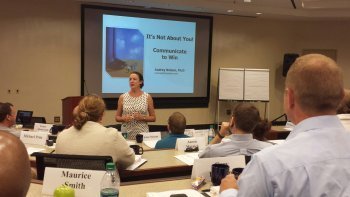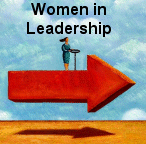Audrey Nelson PhD. is an international trainer, key-note speaker, consultant and author who works with organizations to increase their productivity and profitability through winning communication strategies.
You can reach Audrey at audrey@audreynelson.com
or at 303.448.1800 O - 303-448-1801 F - 303.448.1802 C www.audreynelson.com |
|
Managing Workplace Conflict: The Advantage of Being Direct
Where there are people, there will be conflict; it is natural and normal both in the workplace and at home. The issue becomes how is it expressed. Some conflict is handled in a healthy, respectful and functional way, while other conflict can be unhealthy, disrespectful and dysfunctional. Unfortunately, we have all experienced the latter.
In a New York Times article, Defuse Discord at the Office: Be More Direct, Phyllis Korkki discusses a paper in the Academy of Management Review which addresses how conflict is expressed and identifies four main types of conflict expression:
- High directness/high intensity-Opposition is expressed unambiguously and usually involves shouting, aggressive language and other inappropriate nonverbals like rolling of the eyes and slamming fists on the table.
- High directness/low intensity-Communication is also unambiguous, but the action is debating, discussing and deliberating.
- Low directness/high intensity-Opposition is expressed ambiguously (ignoring or discounting another person's perspective, mean-spirited banter, mobilizing a blocking coalition and back stabbing).
- Low directness/low intensity- This is low voltage, but still insidious. People avoid saying what they really mean, withhold information, tease in "fun," passive-aggressive behavior (convenient forgetting, missing meetings).
The goal and most functional way to handle conflict and express them is the high directness/low intensity. Communication is clear and direct; no ambiguity and lots of transparency. Leadership needs to establish norms that encourage this expression, then employees know what healthy communication looks like at work and the more likely they will practice it themselves.
Did
you miss one of the
Smart Talk Columns? |
Browse
the archives of Audrey’s
2006 to date- Smart Talk Columns on her web!
Simply visit www.audreynelson.com and click on “Newsletters.”
|
|
|
|
|
 |
Audrey presented her keynote, "It's Not About You" at the Emory Conference Center in Atlanta for The Litigation Management College.
|
|
 |
Audrey presented Victors without Victims to a group at Seagate Technology.

|
|
|

Society of Human Resource Management State Conference
Wednesday, September 30, 2015
10:30 am to 11:45 am
Keystone Resort
Audrey's program,
What Organizations Need to Know About Women Leaning In: Women and Leadership
was competitively selected for SHRM-CO conference.
More information and register: www.coshrm.org
 Audrey will be traveling to six countries presenting her new topic Women in Leadership: Communication, Credibility and Power Audrey will be traveling to six countries presenting her new topic Women in Leadership: Communication, Credibility and Power
Click here to learn more
| Audrey's Blog |

|

Have you checked out Audrey’s blog?
Cupid at the Office
Click for article |
|
 What's Behind Women's Intuition? What's Behind Women's Intuition?
Women are a socially subordinate group, and this power-down position has forced women to acquire certain nonverbal (and verbal) skills. Historically, you can see this kind of adaptation in other societies and cultures, and even within different subcultures in the United States..watch
|

Did You Know Audrey began her training career with the largest seminar company in the US?
Twenty eight years ago Audrey was making dinner and received a call at home from Fred Pryor, the founder of Fred Pryor Seminars. He had sent out "talent scouts" to various conferences for the purpose of recruiting speakers and Audrey was discovered when she was a speaker for a Denver women's conference. Fred hired Audrey to design, train other speakers and present two women's seminars. One was titled, "Taking Charge." Today Fred Pryor is the largest public seminar company in the US.
|
|
|
The Gender Communication Handbook –
Conquering Conversational Collisions Between Men and Women
|
 |
The Gender Communication Handbook is for anyone who works with the opposite sex. If you are a part of a management team, in HR, or develop corporate training, this book is a comprehensive guide filled with smart advice, extensive research, self-assessments, and compelling true-to-life case studies. More |
|
Code Switching –
How to Talk so Men will Listen |
 |
Code Switching is a hands-on tool for everyday use at the office. It is a practical resource with how-to steps to help businesswomen conquer the communication nuances between men and women in the workplace. This book explores the gender impact on business talk. - More |
|
You Don’t Say – Navigating Nonverbal Communication Between the Sexes |
 |
You Don't Say is the first book to explore the misunderstandings that often arise between the sexes due to nonverbal communication — and to show readers how to say what they mean and get what they want. More than words, it's nonverbal cues that have the power to improve — or impair — our interactions with the opposite sex at home and in the workplace. |
|
|






